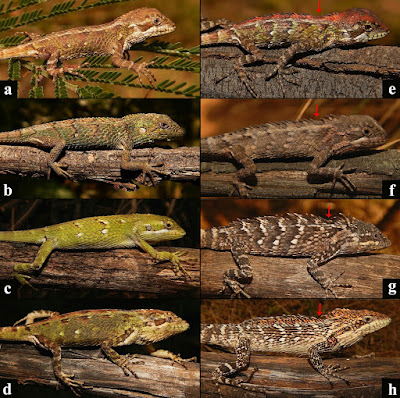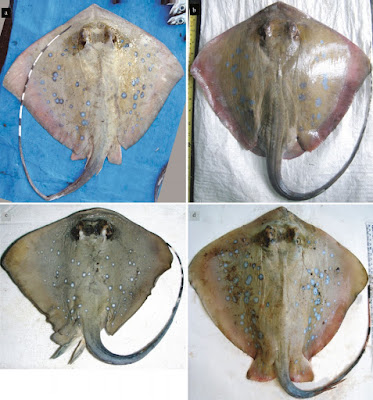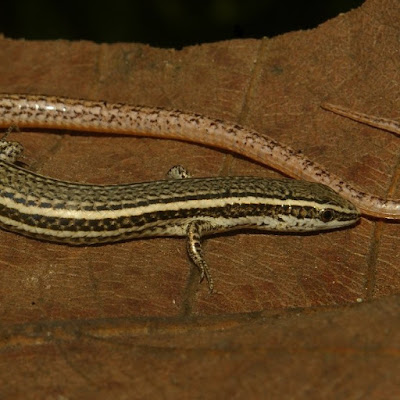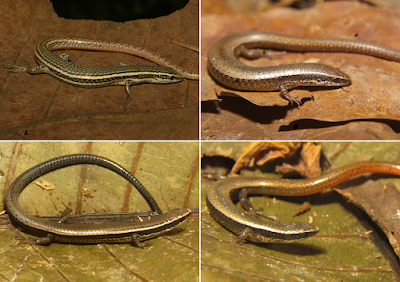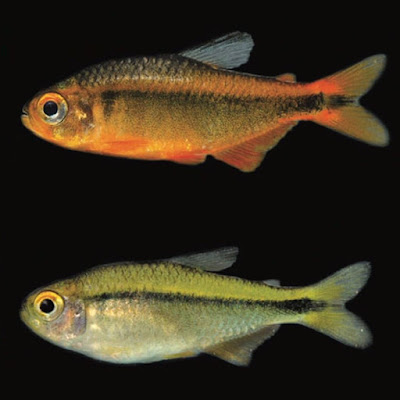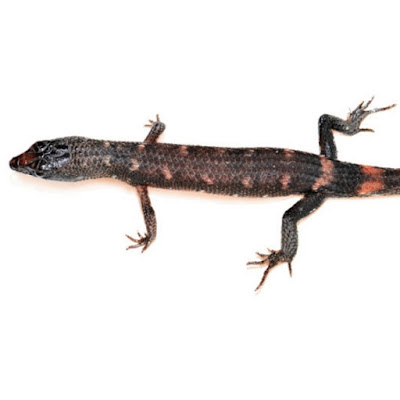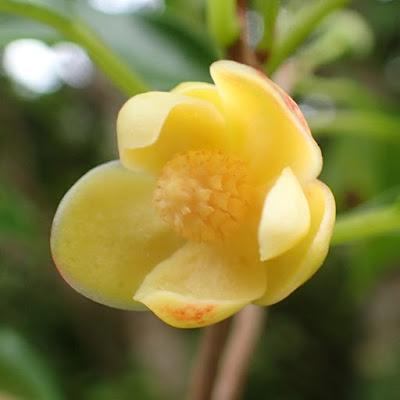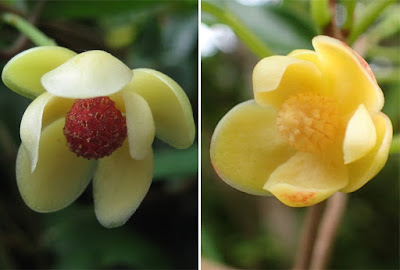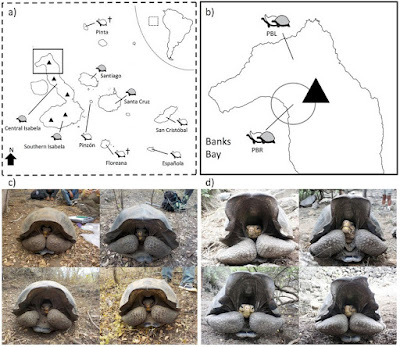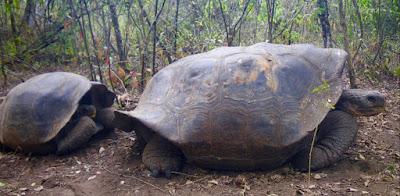[Most Recent Entries] [Calendar View]
Friday, September 15th, 2017
| Time | Event | ||||
| 12:56a | [Herpetology • 2017] An Ontogenetically Stable Sexual Character in A Montane Agamid, Salea horsfieldii Gray, 1845 (Reptilia: Agamidae) from Nilgiris, India
ABSTRACT Many agamid lizards are known to show sexual dimorphism in body shape, colour and ornamentation or a combination of these traits. Adult males of Salea horsfieldii have a discontinuous dorsal crest at the nuchal region, which is a sexually dimorphic character. However, there is no information about the age or size at which this dimorphic ornamentation develops and if the species exhibits sexual shape dimorphism (SShD). The authors studied the morphology of S. horsfieldii and found that its ornamentation is an ontogenetically stable character present in all males, including juveniles. Seven morphological characters were measured to determine if they exhibited SShD at adult and juvenile stages. Analysis of covariance was used to identify differences in morphology between sexes. The results show that only adults exhibited SShD, but not juveniles. Adult males had larger head and foot lengths in comparison to females of the same size. Larger head length in adult males is a sexual fitness trait, which increases bite-force during intra-sexual combats. Although the presence of sexually dimorphic ornamentation right from the juvenile stage is rare in agamids, S. horsfieldii is an exception . The role of sexually dimorphic ornamentation at juvenile stages remains unknown and requires further investigation. KEYWORDS: Lizard, ontogeny, ornament, Salea, sexual dimorphism Caleb Daniel G., Rachakonda Sreekar and V. Deepak. 2017. An Ontogenetically Stable Sexual Character in A Montane Agamid, Salea horsfieldii Gray, 1845 (Reptilia: Agamidae) from Nilgiris, India. Journal of Natural History. DOI: 10.1080/00222933.2017.1369188 | ||||
| 1:02a | [Ichthyology • 2017] Diagnostic Description and Geographic Distribution of Four New Cryptic Species of the Blue-spotted Maskray Species Complex (Myliobatoidei: Dasyatidae; Neotrygon spp.) based on DNA Sequences; Neotrygon bobwardi, N. malaccensis, N. molu Abstract Nine morphologically similar but genetically distinct lineages in the blue-spotted maskray species complex, previously Neotrygon kuhlii (Müller and Henle) qualify as cryptic species. Four of these lineages have been previously described as Neotrygon australiae Last, White and Séret, Neotrygon caeruleopunctata Last, White and Séret, Neotrygon orientale Last, White and Séret, and Neotrygon varidens (Garman), but the morphological characters used in the descriptions off ered poor diagnoses and their geographic distributions were not delineated precisely. The objective of the present work is to complete the description of the cryptic species in the complex. Here, an additional four lineages are described as new species on the basis of their mitochondrial DNA sequences: Neotrygon bobwardi, whose distribution extends from the northern tip of Aceh to the western coast of Sumatera; Neotrygon malaccensis, sampled from the eastern part of the Andaman Sea and from the Malacca Strait; Neotrygon moluccensis, from the eastern half of the Banda Sea; and Neotrygon westpapuensis from the central portion of northern West Papua. The geographic distributions of N. australiae, N. coeruleopunctata, N. orientale, and N. varidens are updated. For each species, a diagnosis is provided in the form of a combination of private or partly-private nucleotides at 2–4 nucleotide sites along a 519-base pair fragment of the CO1 gene. We believe that the present taxonomic revision will provide information relevant to the sound management and conservation of cryptic species of the blue-spotted maskray in the Coral Triangle region. Keyword : molecular taxonomy; diagnosis; distribution Neotrygon bobwardi sp. nov. Clade II (Borsa et al., 2016b); Neotrygon kuhlii clade II (Arlyza et al., 2013a; Borsa et al., 2016a); Neotrygon kuhlii (Borsa et al., 2013a). Distribution: the type locality of N. bobwardi sp. nov. is Meulaboh, northwestern coast of Sumatra Island. Based on present study, its distribution includes the northern tip of the Aceh region and all the western coast of Sumatra south to Padang. Etymology: the species is named after Robert D. (Bob) Ward, one of the leaders of the fi sh barcoding initiative (Ward et al., 2009). One of his noted contributions in this fi eld was the DNA-barcoding survey of Australian chondrichthyans, which included bluespotted maskray samples from the Coral Triangle region (Ward et al., 2008). R. D. Ward and co-authors suspected the occurrence of cryptic species within the nominal species N. kuhlii, based on an unusually high level of genetic divergence among geographic populations, at the CO1 locus. We chose to name after him the bluespotted maskray species that occurs on the Indian-Ocean coast of Sumatra, as an acknowledgement of his contribution to the systematics of chondrichthyans. Proposed vernacular names: Bob Ward’s bluespotted maskray (English); pari masker totol biru Pak Bob (Indonesian); raie pastenague à points bleus de Bob Ward (French). Neotrygon malaccensis sp. nov. Clade III (Borsa et al., 2016b); Neotrygon kuhlii clade III (Arlyza et al., 2013a; Borsa et al., 2016a); Neotrygon kuhlii clade 7 (Puckridge et al., 2013); Neotrygon kuhlii (Borsa et al., 2013a). Distribution: the type locality of N. malaccensis sp. nov. is Kuala Lama, Malacca Strait (03°39′N, 98°59′E). Specimens of the same species were sampled from Perbaungan, a neighbouring locality in the Malacca Strait and from the western coast of the Kra isthmus, Thailand. Known distribution, based on present study: northern part of Malacca Strait and eastern Andaman Sea. Etymology: epithet malaccensis refers to the geographic origin of the type material, the Malacca Strait. It is the latinized geographical adjectival form of noun “Malacca”. Proposed vernacular names: the Malacca Strait bluespotted maskray (English); pari masker totol biru Selat Melaka (Indonesian); raie pastenague masquée à points bleus du détroit de Malacca (French). Neotrygon moluccensis sp. nov. Clade VII (Borsa et al., 2016b); Neotrygon kuhlii Clade VII (Arlyza et al., 2013a; Borsa et al., 2016a); Neotrygon kuhlii (Borsa et al., 2013a). Distribution: the type locality of N. moluccensis sp. nov. is Tual, Kei Islands, Moluccas, Indonesia. Specimens of the same species were sampled from Ambon, Moluccas. Known distribution, based on present study: eastern half of Banda Sea. Etymology: epithet moluccensis refers to the geographic origin of the type material, the Molucca islands. It is the latinized geographical adjectival form of noun “Molucca”. Proposed vernacular names: Moluccan bluespotted maskray (English); pari masker totol biru Maluku (Indonesian); raie pastenague masquée à points bleus des Moluques (French). Neotrygon westpapuensis sp. nov. Clade VIII (Borsa et al., 2016b); Neotrygon kuhlii clade VIII (Arlyza et al., 2013a; Borsa et al., 2016a); Neotrygon kuhlii (Borsa et al., 2013a). Distribution: the type locality of N. westpapuensis sp. nov. is Biak Island north of Cenderawasih Bay, West Papua. As all samples we have of this species originate from Biak and from nearby Numfor Island only, amid a wide unsampled region (Fig.1a), no distribution map can be inferred at present. The geological features of the northern coastline of the Vogelkop peninsula, where the shallow-water habitat favourable to blue-spotted maskrays is absent, isolate the reef fauna of Cenderawasih Bay from that of western West Papua further west. Further research is needed to delineate the precise geographic distribution of N. westpapuensis sp. nov. Etymology: Named for the country of type locality, West Papua as it is spelled since 1961 (Saltford, 2003). Epithet westpapuensis is the latinized geographical adjectival form of noun “West Papua”, with no emendation. Proposed vernacular names: West Papuan bluespotted maskray (English); pari masker totol biru West Papua (Indonesian); raie pastenague masquée à points bleus de Papouasie Occidentale (French). Philippe Borsa, Irma S. Arlyza, Thierry B. Hoareau and Kang-Ning Shen. 2017. Diagnostic Description and Geographic Distribution of Four New Cryptic Species of the Blue-spotted Maskray Species Complex (Myliobatoidei: Dasyatidae; Neotrygon spp.) based on DNA Sequences. Chinese Journal of Oceanology and Limnology. DOI: 10.1007/s00343-018-7056-2 | ||||
| 1:20a | [Herpetology • 2017] Gymnophthalmus marconaterai • A New Species of Gymnophthalmus (Squamata: Gymnophthalmidae) from Sand Dunes of the Llanos of Apure, Venezuela
Abstract A new species of Gymnophthalmus is described from the Llanos of Venezuela in Apure State. Gymnophthalmus marconaterai sp. nov. is found mostly on sand dunes and is seemingly endemic to the eolic plains of Apure State. The new species differs from all other species of Gymnophthalmus with 13 scales around the midbody, by having distinctive coloration that includes complete and well-defined lateral and dorsolateral white stripes, a white ventral coloration in preservative (creamish white or yellow in life) devoid of dark markings, and salmon pink tail in life. Keywords: Reptilia, Endemism, eolic plains, new species, reptiles, taxonomy, Orinoquia Juan E. García-Pérez and Walter E. Schargel. 2017. A New Species of Gymnophthalmus (Squamata: Gymnophthalmidae) from Sand Dunes of the Llanos of Apure, Venezuela. Zootaxa. 4318(3); 576–586. DOI: 10.11646/zootaxa.4318.3.9 | ||||
| 3:57a | [Ichthyology • 2017] Hyphessobrycon myrmex • A New Sexually Dichromatic Miniature Hyphessobrycon (Characiformes: Characidae) from the Rio Formiga, upper Rio Juruena basin, Mato Grosso, Brazil, with A Review of Sexual Dichromatism in Characiformes
Abstract Hyphessobrycon myrmex sp. nov., is described from the Rio Formiga, upper Rio Juruena, upper Rio Tapajós basin, Mato Grosso, Brazil. The new species can be distinguished from congeners by having the lower half of the body deeply pigmented with dark chromatophores, chromatophores concentrated above the anal fin and forming a broad, diffuse, dark midlateral stripe and by having a dense concentration of dark chromatophores along unbranched dorsal-fin rays and distal portions of the two or three subsequent branched rays. In life, H. myrmex exhibits a conspicuous sexual dichromatism, with adult males red to orange and females and immatures pale yellow. A list containing 108 sexually dichromatic taxa in six families of Characiformes is provided and the distribution of this poorly known type of dimorphism across the Characiformes is discussed. Key words: Amazon basin; miniaturization; Neotropical ichthyofauna; sexual dimorphism; Tapajós.
Hyphessobrycon myrmex Etymology: The specific epithet myrmex is derived from the Greek word for ant, in allusion to the small size of adult specimens of the species and also refers to the type locality, the Rio Formiga, which means ‘Ant River’ in Portuguese. M. N. L. Pastana, F. C. P. Dagosta and A. L. H. Esguícero. 2017. A New Sexually Dichromatic Miniature Hyphessobrycon (Teleostei: Characiformes: Characidae) from the Rio Formiga, upper Rio Juruena basin, Mato Grosso, Brazil, with A Review of Sexual Dichromatism in Characiformes. Journal of Fish Biology. DOI: 10.1111/jfb.13449 | ||||
| 4:04a | [Herpetology • 2017] Rediscovery and Redescription of Tropidophorus micropus van Lidth de Jeude, 1905 (Squamata: Scincidae) from Sarawak, East Malaysia (Borneo)
Abstract Tropidophorus micropus van Lidth de Jeude, 1905, described from the upper Mahakkam River, Kalimantan, Indonesia, is here redescribed, based on new material from upper Baleh, Sarawak, East Malaysia (Borneo), collected after over 100 years. The new locality is ca. 94 km to the north of the type locality, and comprises a new national record. Keywords: Tropidophorus micropus; rediscovery; Scincidae; Malaysia; Borneo Tropidophorus micropus van Lidth de Jeude, 1905 was described from a unique specimen (RMNH 4452, presumed to be an adult male, based on swollen tail base), collected from “Long Bloe Upper Mahakkam” (= Long Blu, also spelt Long Bloéoe, 00.71667°N; 114.2500°E; on the upper reaches of Sungei Mahakam, Kalimantan Timur Propinsi, Indonesia, on the island of Borneo). No images were provided in the original description, and the holotype is illustrated here (Figure 1). Subsequent authors (e.g., de Rooij, 1915) referred to the species, but apparently no further specimens have been collected. The recent records of the species by Stuebing et al. (1999) and Das (2004) are based on misidentified specimens. In May 2015, two specimens of Tropidophorus were collected during an expedition to the headwaters of Sungei Baleh, central Sarawak, that we allocate to this nominal species. This constitutes the rediscovery of the poorly known species, as well as the first confirmed record for Sarawak and Malaysia. We provide an expanded description of these specimens, including, for the first time, a description of its colouration as well as images. .....
Ecological Notes and Distribution: The series was collected from narrow crevices of rocky banks of small streams at the headwaters of Sungei Baleh (Figure 4). Both females contained two yellowish-cream colored ova, and visible externally in life. The new locality provides the first record for both Sarawak and Malaysia, and lies ca. 94 km to the north of the type locality, across Pengunungan Mueller (= Müller Range) that forms the boundary between Sarawak (Malaysia) in the north and Kalimantan (Indonesia) to the south. Yong Min PUI and Indraneil DAS. 2017. Rediscovery and Redescription of Tropidophorus micropus van Lidth de Jeude, 1905 (Squamata: Sauria: Scincidae) from Sarawak, East Malaysia (Borneo). Asian Herpetological Research. 8(2); 147-150. DOI: 10.16373/j.cnki.ahr.160015 | ||||
| 9:48a | [Botany • 2017] Emended Description and Resurrection of Kadsura matsudae (Schisandraceae)
Abstract The taxonomic identity of Kadsura matsudae is reevaluated. This taxon is often treated as a synonym of K. japonica, a species known from Japan, Korea, and Taiwan. When studying the type materials of K. matsudae, however, we noted that some of its morphological characters, such as the non-contiguous thecae in adjacent stamens, do not fall within the typical variation range of K. japonica. Phylogenetic analysis suggests that although K. matsudae is retrieved within the sect. Kadsura clade, it is not closely related to K. japonica. We therefore propose that K. matsudae should be recognized as a distinct species. Because the protologue of K. matsudae lacks sufficient detail with regards to stamen morphology, which is one of the most important characteristics for identifying the species, we provide an emended description of K. matsudae based on the holotype specimen and newly collected specimens. Keywords: Kadsura, Schisandraceae, Japan, Ryukyu Islands, Taiwan, taxonomy, Eudicots Kadsura matsudae Hayata (1920: 4, as “K. matsudai”) emend. Suetsugu & T.C.Hsu
Kenji Suetsugu, Tian-Chuan Hsu, Tsugutaka Toma, Takashi Miyake and Richard M. K. Saunders. 2017. Emended Description and Resurrection of Kadsura matsudae (Schisandraceae). Phytotaxa. 311(3); 255–262. DOI: 10.11646/phytotaxa.311.3.5 Mistaken identity of East Asian vine species resolved after 100 years phy.so/418036946 via @physorg_com | ||||
| 10:10a | [Herpetology • 2017] Identification of Genetically Important Individuals of the Rediscovered Floreana Galápagos Giant Tortoise (Chelonoidis elephantopus) Provide Founders for Species Restoration Program Abstract Species are being lost at an unprecedented rate due to human-driven environmental changes. The cases in which species declared extinct can be revived are rare. However, here we report that a remote volcano in the Galápagos Islands hosts many giant tortoises with high ancestry from a species previously declared as extinct: Chelonoidis elephantopus or the Floreana tortoise. Of 150 individuals with distinctive morphology sampled from the volcano, genetic analyses revealed that 65 had C. elephantopus ancestry and thirty-two were translocated from the volcano’s slopes to a captive breeding center. A genetically informed captive breeding program now being initiated will, over the next decades, return C. elephantopus tortoises to Floreana Island to serve as engineers of the island’s ecosystems. Ironically, it was the haphazard translocations by mariners killing tortoises for food centuries ago that created the unique opportunity to revive this “lost” species today. Joshua M. Miller, Maud C. Quinzin, Nikos Poulakakis, James P. Gibbs, Luciano B. Beheregaray, Ryan C. Garrick, Michael A. Russello, Claudio Ciofi, Danielle L. Edwards, Elizabeth A. Hunter, Washington Tapia, Danny Rueda, Jorge Carrión, Andrés A. Valdivieso and Adalgisa Caccone. 2017. Identification of Genetically Important Individuals of the Rediscovered Floreana Galápagos Giant Tortoise (Chelonoidis elephantopus) Provide Founders for Species Restoration Program. Scientific Reports. 7, Article number: 11471. DOI: 10.1038/s41598-017-11516-2 Back from the dead—how to revive a lost species phy.so/424511176 via @physorg_com |
| << Previous Day |
2017/09/15 [Calendar] |
Next Day >> |
